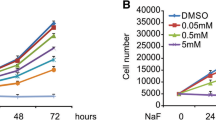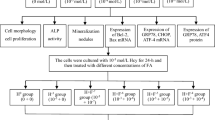Abstract
Hyperhomocysteinemia has been shown to increase the incidence of osteoporosis and osteoporotic fractures. Endoplasmic reticulum (ER) stress was recently shown to be associated with apoptosis in several types of cells. In this study, we determined the effect of homocysteine (Hcy) on the apoptosis of osteoblastic cells and investigated whether ER stress participates in Hcy-induced osteoblast apoptosis. Human osteoblastic cells were incubated with Hcy. Hcy dose-dependently decreased cell viability and increased apoptosis in osteoblastic cells. Osteoblastic cells are more susceptible to Hcy-mediated cell death than other cell types. Expression of cleaved caspase-3 was significantly increased by Hcy, and pretreatment with caspase-3 inhibitor rescued the cell viability by Hcy. Hcy treatment led to an increase in release of mitochondrial cytochrome c. It also triggered ER stress by increased expression of glucose-regulated protein 78, inositol-requiring transmembrane kinase and endonuclease 1α (IRE-1α), spliced X-box binding protein, activating transcription factor 4, and C/EBP homologous protein. Silencing IRE-1α expression by small interfering RNA effectively suppressed Hcy-induced apoptosis of osteoblastic cells. Our results suggest that hyperhomocysteinemia induces apoptotic cell death in osteoblasts via ER stress.





Similar content being viewed by others
Abbreviations
- IRE-1α:
-
Inositol-requiring transmembrane kinase and endonuclease 1α
- sXBP-1:
-
Spliced X-box binding protein
- ATF4:
-
Activating transcription factor 4
- Bax:
-
Bcl-2-associated X protein
- Bcl-2:
-
B-cell lymphoma 2
- CHOP:
-
C/EBP homologous protein
- ER:
-
Endoplasmic reticulum
- FLS:
-
Fibroblast-like synoviocytes
- GRP78:
-
Glucose-regulated protein 78
- Hcy:
-
Homocysteine
- HUVECs:
-
Human umbilical vein endothelial cells
- PERK:
-
PKR-like ER-associated kinase
- UPR:
-
Unfolded protein response
References
Kanis JA, McCloskey EV, Johansson H, Oden A (2009) Approaches to the targeting of treatment for osteoporosis. Nat Rev Rheumatol 5:425–431
Seeman E (2002) Pathogenesis of bone fragility in women and men. Lancet 359:1841–1850
Manolagas SC (1998) Cellular and molecular mechanisms of osteoporosis. Aging (Milano) 10:182–190
Weinstein RS, Manolagas SC (2000) Apoptosis and osteoporosis. Am J Med 108:153–164
Harvey N, Dennison E, Cooper C (2010) Osteoporosis: impact on health and economics. Nat Rev Rheumatol 6:99–105
Levasseur R (2009) Bone tissue and hyperhomocysteinemia. Jt Bone Spine 76:234–240
Yap S, Naughten E (1998) Homocystinuria due to cystathionine beta-synthase deficiency in Ireland: 25 years’ experience of a newborn screened and treated population with reference to clinical outcome and biochemical control. J Inherit Metab Dis 21:738–747
Testai FD, Gorelick PB (2010) Inherited metabolic disorders and stroke part 2: homocystinuria, organic acidurias, and urea cycle disorders. Arch Neurol 67:148–153
van Meurs JB, Dhonukshe-Rutten RA, Pluijm SM et al (2004) Homocysteine levels and the risk of osteoporotic fracture. N Engl J Med 350:2033–2041
McLean RR, Jacques PF, Selhub J, Tucker KL, Samelson EJ, Broe KE, Hannan MT, Cupples LA, Kiel DP (2004) Homocysteine as a predictive factor for hip fracture in older persons. N Engl J Med 350:2042–2049
Gjesdal CG, Vollset SE, Ueland PM, Refsum H, Meyer HE, Tell GS (2007) Plasma homocysteine, folate, and vitamin B 12 and the risk of hip fracture: the hordaland homocysteine study. J Bone Miner Res 22:747–756
Herrmann M, Wildemann B, Claes L, Klohs S, Ohnmacht M, Taban-Shomal O, Hubner U, Pexa A, Umanskaya N, Herrmann W (2007) Experimental hyperhomocysteinemia reduces bone quality in rats. Clin Chem 53:1455–1461
Gupta S, Kuhnisch J, Mustafa A, Lhotak S, Schlachterman A, Slifker MJ, Klein-Szanto A, High KA, Austin RC, Kruger WD (2009) Mouse models of cystathionine beta-synthase deficiency reveal significant threshold effects of hyperhomocysteinemia. FASEB J 23:883–893
Anagnostis P, Karagiannis A, Kakafika AI, Tziomalos K, Athyros VG, Mikhailidis DP (2009) Atherosclerosis and osteoporosis: age-dependent degenerative processes or related entities? Osteoporos Int 20:197–207
Zhang K, Kaufman RJ (2008) From endoplasmic-reticulum stress to the inflammatory response. Nature 454:455–462
Ji C, Kaplowitz N (2003) Betaine decreases hyperhomocysteinemia, endoplasmic reticulum stress, and liver injury in alcohol-fed mice. Gastroenterology 124:1488–1499
Kim HJ, Cho HK, Kwon YH (2008) Synergistic induction of ER stress by homocysteine and beta-amyloid in SH-SY5Y cells. J Nutr Biochem 19:754–761
Chigurupati S, Wei Z, Belal C, Vandermey M, Kyriazis GA, Arumugam TV, Chan SL (2009) The homocysteine-inducible endoplasmic reticulum stress protein counteracts calcium store depletion and induction of CCAAT enhancer-binding protein homologous protein in a neurotoxin model of Parkinson disease. J Biol Chem 284:18323–18333
Zhang C, Cai Y, Adachi MT, Oshiro S, Aso T, Kaufman RJ, Kitajima S (2001) Homocysteine induces programmed cell death in human vascular endothelial cells through activation of the unfolded protein response. J Biol Chem 276:35867–35874
Shirakawa K, Maeda S, Gotoh T et al (2006) CCAAT/enhancer-binding protein homologous protein (CHOP) regulates osteoblast differentiation. Mol Cell Biol 26:6105–6116
Pereira RC, Stadmeyer LE, Smith DL, Rydziel S, Canalis E (2007) CCAAT/enhancer-binding protein homologous protein (CHOP) decreases bone formation and causes osteopenia. Bone 40:619–626
Yoo SA, Park BH, Park GS, Koh HS, Lee MS, Ryu SH, Miyazawa K, Park SH, Cho CS, Kim WU (2006) Calcineurin is expressed and plays a critical role in inflammatory arthritis. J Immunol 177:2681–2690
Lee SJ, Kim KM, Namkoong S et al (2005) Nitric oxide inhibition of homocysteine-induced human endothelial cell apoptosis by down-regulation of p53-dependent Noxa expression through the formation of S-nitrosohomocysteine. J Biol Chem 280:5781–5788
Yuan Q, Jiang DJ, Chen QQ, Wang S, Xin HY, Deng HW, Li YJ (2007) Role of asymmetric dimethylarginine in homocysteine-induced apoptosis of vascular smooth muscle cells. Biochem Biophys Res Commun 356:880–885
Kim DJ, Koh JM, Lee O, Kim NJ, Lee YS, Kim YS, Park JY, Lee KU, Kim GS (2006) Homocysteine enhances apoptosis in human bone marrow stromal cells. Bone 39:582–590
Orrenius S, Zhivotovsky B, Nicotera P (2003) Regulation of cell death: the calcium-apoptosis link. Nat Rev Mol Cell Biol 4:552–565
Degli Esposti M (2004) Mitochondria in apoptosis: past, present and future. Biochem Soc Trans 32:493–495
Cotter TG (2009) Apoptosis and cancer: the genesis of a research field. Nat Rev Cancer 9:501–507
Hengartner MO (2000) The biochemistry of apoptosis. Nature 407:770–776
Althausen S, Paschen W (2000) Homocysteine-induced changes in mRNA levels of genes coding for cytoplasmic- and endoplasmic reticulum-resident stress proteins in neuronal cell cultures. Brain Res Mol Brain Res 84:32–40
Shen X, Ellis RE, Lee K et al (2001) Complementary signaling pathways regulate the unfolded protein response and are required for C. elegans development. Cell 107:893–903
Cox JS, Shamu CE, Walter P (1993) Transcriptional induction of genes encoding endoplasmic reticulum resident proteins requires a transmembrane protein kinase. Cell 73:1197–1206
Bellido T, Ali AA, Plotkin LI, Fu Q, Gubrij I, Roberson PK, Weinstein RS, O’Brien CA, Manolagas SC, Jilka RL (2003) Proteasomal degradation of Runx2 shortens parathyroid hormone-induced anti-apoptotic signaling in osteoblasts. A putative explanation for why intermittent administration is needed for bone anabolism. J Biol Chem 278:50259–50272
Tsuboi M, Kawakami A, Nakashima T et al (1999) Tumor necrosis factor-alpha and interleukin-1beta increase the Fas-mediated apoptosis of human osteoblasts. J Lab Clin Med 134:222–231
Suhara T, Fukuo K, Yasuda O, Tsubakimoto M, Takemura Y, Kawamoto H, Yokoi T, Mogi M, Kaimoto T, Ogihara T (2004) Homocysteine enhances endothelial apoptosis via upregulation of Fas-mediated pathways. Hypertension 43:1208–1213
Szegezdi E, Logue SE, Gorman AM, Samali A (2006) Mediators of endoplasmic reticulum stress-induced apoptosis. EMBO Rep 7:880–885
Zhang K, Kaufman RJ (2006) The unfolded protein response: a stress signaling pathway critical for health and disease. Neurology 66:S102–S109
Morishima N, Nakanishi K, Takenouchi H, Shibata T, Yasuhiko Y (2002) An endoplasmic reticulum stress-specific caspase cascade in apoptosis. Cytochrome c-independent activation of caspase-9 by caspase-12. J Biol Chem 277:34287–34294
Cai Y, Zhang C, Nawa T, Aso T, Tanaka M, Oshiro S, Ichijo H, Kitajima S (2000) Homocysteine-responsive ATF3 gene expression in human vascular endothelial cells: activation of c-Jun NH(2)-terminal kinase and promoter response element. Blood 96:2140–2148
Zhang C, Kawauchi J, Adachi MT, Hashimoto Y, Oshiro S, Aso T, Kitajima S (2001) Activation of JNK and transcriptional repressor ATF3/LRF1 through the IRE1/TRAF2 pathway is implicated in human vascular endothelial cell death by homocysteine. Biochem Biophys Res Commun 289:718–724
Chen YR, Meyer CF, Tan TH (1996) Persistent activation of c-Jun N-terminal kinase 1 (JNK1) in gamma radiation-induced apoptosis. J Biol Chem 271:631–634
Ron D, Walter P (2007) Signal integration in the endoplasmic reticulum unfolded protein response. Nat Rev Mol Cell Biol 8:519–529
Zinszner H, Kuroda M, Wang X, Batchvarova N, Lightfoot RT, Remotti H, Stevens JL, Ron D (1998) CHOP is implicated in programmed cell death in response to impaired function of the endoplasmic reticulum. Genes Dev 12:982–995
Yang X, Matsuda K, Bialek P et al (2004) ATF4 is a substrate of RSK2 and an essential regulator of osteoblast biology; implication for Coffin–Lowry syndrome. Cell 117:387–398
Zhang P, McGrath B, Li S, Frank A, Zambito F, Reinert J, Gannon M, Ma K, McNaughton K, Cavener DR (2002) The PERK eukaryotic initiation factor 2 alpha kinase is required for the development of the skeletal system, postnatal growth, and the function and viability of the pancreas. Mol Cell Biol 22:3864–3874
Lisse TS, Thiele F, Fuchs H et al (2008) ER stress-mediated apoptosis in a new mouse model of osteogenesis imperfecta. PLoS Genet 4:e7
Berglund S, Sodergren A, Wallberg Jonsson S, Rantapaa Dahlqvist S (2009) Atherothrombotic events in rheumatoid arthritis are predicted by homocysteine—a six-year follow-up study. Clin Exp Rheumatol 27:822–825
Lazzerini PE, Selvi E, Lorenzini S, Capecchi PL, Ghittoni R, Bisogno S, Catenaccio M, Marcolongo R, Galeazzi M, Laghi-Pasini F (2006) Homocysteine enhances cytokine production in cultured synoviocytes from rheumatoid arthritis patients. Clin Exp Rheumatol 24:387–393
Kokame K, Kato H, Miyata T (1996) Homocysteine-respondent genes in vascular endothelial cells identified by differential display analysis. GRP78/BiP and novel genes. J Biol Chem 271:29659–29665
Blass S, Union A, Raymackers J, Schumann F, Ungethum U, Muller-Steinbach S, De Keyser F, Engel JM, Burmester GR (2001) The stress protein BiP is overexpressed and is a major B and T cell target in rheumatoid arthritis. Arthritis Rheum 44:761–771
Hampton RY (2002) ER-associated degradation in protein quality control and cellular regulation. Curr Opin Cell Biol 14:476–482
Amano T, Yamasaki S, Yagishita N et al (2003) Synoviolin/Hrd1, an E3 ubiquitin ligase, as a novel pathogenic factor for arthropathy. Genes Dev 17:2436–2449
Acknowlegment
This work was supported by grants from the Korea Health 21R&D Project, Ministry of Health & Welfare, Republic of Korea (No. A040018), and the Korea Healthcare Technology R&D Project, Ministry for Health, Welfare and Family Affairs (No. A092258 and A084948), and National Research Foundation of Korea (NRF) funded by the Ministry of Education, Science and Technology (No. 314-2008-1-E00113).
Conflict of interest
None.
Author information
Authors and Affiliations
Corresponding author
Additional information
S.-J. Park and K.-J. Kim contributed equally to this work.
About this article
Cite this article
Park, SJ., Kim, KJ., Kim, WU. et al. Involvement of endoplasmic reticulum stress in homocysteine-induced apoptosis of osteoblastic cells. J Bone Miner Metab 30, 474–484 (2012). https://doi.org/10.1007/s00774-011-0346-9
Received:
Accepted:
Published:
Issue Date:
DOI: https://doi.org/10.1007/s00774-011-0346-9




